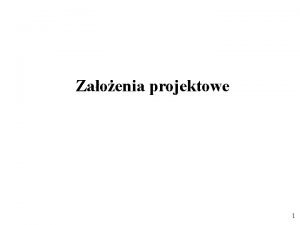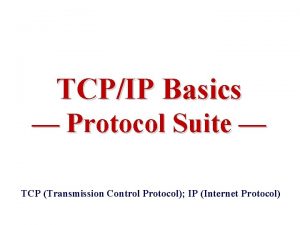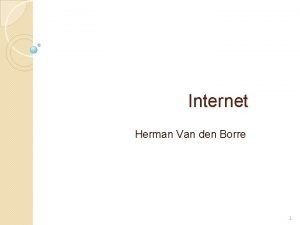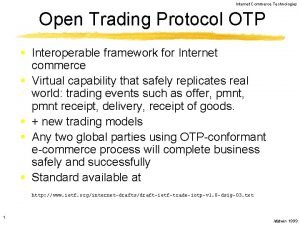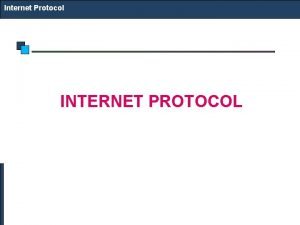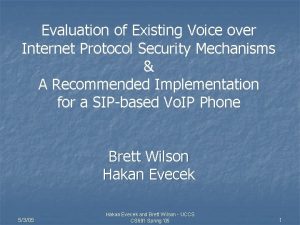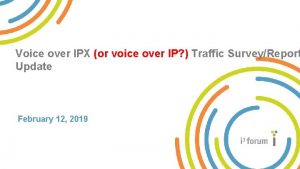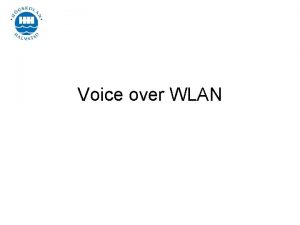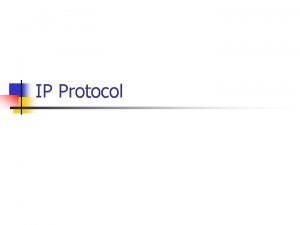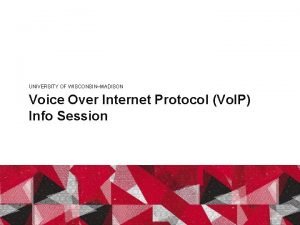Voice over Internet Protocol Vo IP Security Affects











- Slides: 11

Voice over Internet Protocol (Vo. IP) Security Affects on the IP Network Architecture Net@Edu Conference ICS – Wireless Group Meeting Tempe, Arizona February 6, 2005 Jose J. Valdes, Jr. Colorado State University 1

Convergence Ø “Today’s networks are being architected with converged, real time, voice, data, and video applications in mind. ” Ø “It is this ability to integrate voice, data, and video applications using a single network infrastructure that makes deployment of IP telephony platform a essential step toward creating a next-generation network. ” Ø The next-generation network has different and extended architectural requirements, in part because of Vo. IP, e. g. , security. (1) 2

Vo. IP Security Ø “Security must prevent theft of service, authenticate users, and repel a range of attacks from outside and inside the firewall. ” Ø “With the introduction of VOIP, the need for security is compounded because now we must protect two invaluable assets, our data and our voice. ” (video and mobile). Ø “The key to securing VOIP is to use the security mechanisms like those deployed in the data networks (firewall, encryption, antivirus, pop-up protection, O. S. updates, etc. ). ” (2) (3) 3

Vo. IP Security Challenges Ø Quality of Service Ø Network Elements Ø Security Breaches Ø Denial of Service (Do. S) Power failure Viruses, Trojan Horse Physical security Operating System Life and Safety (E-911) Access Ø Disruption Ø Confidentiality and privacy Ø 802. 11 (Qo. S) Latency Ø Jitter Ø Packet loss Ø Ø Ø Ø Protocols Ø H. 323 Ø SIP 4

Quality of Service (Qo. S) “Quality of Service (Qo. S) refers to the capacity of a network to provide better service to selected network traffic over various technologies …, and IP routed networks …” (4) Ø Latency is the time it takes for data to get from the source to the destination and is introduced from various network and Vo. IP components, e. g. , encryption encoding and decoding. Ø Jitter is introduced when data packets have different latency and packets become out of sequence. Ø Packet loss is when data packets do not arrive at the destination or arrive too late to be processed. Ø (4) 5

QOS Ø “The key to conquering Qo. S issues like latency and bandwidth congestion is speed. ” Ø “…every facet of network traversal must be completed quickly in Vo. IP. ” Ø Firewalls/NAT traversal and traffic encryption/decryption are latency producers and network congestion generators, but must effective means to secure a network. The “good and bad news”. (3) 6

Security Breaches Ø Access Ø Ø Ø Disruption Ø Ø Ø Unauthentication - intrusion detection and application access control Protection and updating of administrative passwords Denial of Service (Do. S) – VLAN, firewall, routers, digital certificates Network congestion – Qo. S, increased bandwidth Confidentiality and Privacy Ø Eavesdropping & IP spoofing 7

Network Elements Denial of Service (Do. S) – see slide # 7 Ø Power failure – UPS, generators Ø Viruses, Trojan Horse – application and O. S. patches and updates, security policies Ø Physical security – access controls, policies Ø Operating System – patches, updates Ø Life and Safety (E-911) – static IP address, relocation policies Ø Ø 802. 11 evolving IP mobile devices or dual mode with cellular 8

IP Security Profiles Ø ITU – T H. 234 v 2 & v 3 defines different security profiles for product interoperability under the H. 323 suite of protocols’ Annex D, E, and F. Suite designed for real time audio, video, multimedia, and data. Ø SIP security features described in RFC 3261 (IETF). Designed for Vo. IP and updated for video and messaging. Ø Some will argue that these protocols were designed from different perspectives. 9

Bottom Line and Discussion Ø Expectations for Vo. IP will be based on the performance and availability of legacy telephony systems!! Ø How will Vo. IP affect the IP network architecture? Ø Will “traditional” IP security mechanisms and policies be effective or detrimental to Vo. IP on a convergent network? Ø How to identify the accommodations or “trade offs” that will be acceptable in support of Vo. IP on a convergent network? 10

References (1) Broadcom. “Critical Steps for Successful Vo. IP Deployment. ” White Paper October 2004 Broadcom Corporation Irvine, CA. (2) Shore, Joel. “IP Telephony Security: An Overview. ” Network. World URL: networkworld@reprintbuyer. com Kuhn, R. D. , Walsh, T. J. , & Fries, S. , “Security Considerations for Voice Over IP Systems: Recommendations of the National Institute of Standards and Technology. ” National Institute of Standards and Technology, Gaithersburg, MD. January 2005. Cisco. “Internetworking Technology Handbook. ” 2003. URL: http: //www. cisco. com/univercd/cc/td/doc/cisintwrk/ito_doc (26 October 2004) Tucker, G. S. , “Voice Over Internet Protocol (Vo. IP) and Security. ” GIAC Security Essentials Certification (GSEC), v 1. 4 c, option 1, 26 October 2004 11 (3) (4) (5)
 Voice over internet protocol
Voice over internet protocol Thinking affects our language, which then affects our:
Thinking affects our language, which then affects our: Security architecture for the internet protocol
Security architecture for the internet protocol Private securit
Private securit Internet transport protocol in computer networks
Internet transport protocol in computer networks Dongyang mirae university
Dongyang mirae university Internet official protocol standards
Internet official protocol standards Internet protocol cursus
Internet protocol cursus Iotp
Iotp Iptv internet protocol television
Iptv internet protocol television Adaptive internet protocol
Adaptive internet protocol Active and passive voice simple past tense examples
Active and passive voice simple past tense examples
